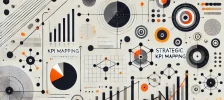
Essential AI-Powered KPI Formulas for Predictive Analytics
How do you effectively translate AI predictive capabilities into actionable KPIs for your organization? These powerful formulas provide a foundation for implementing advanced predictive measurement in operations, forecasting, and time-to-market scenarios.
Table
AI-Task Delay Risk Index (AI-TDRI)
To measure the probability that a specific task will be delayed before it happens, allowing for proactive intervention:
AI-TDRI = (α × CD + β × AW + γ × DH + δ × ERE + ε × PMI) × CF
Where:
- CD = Critical Dependencies Status (0-1)
- AW = Assignee Workload Factor (1.0 = 100% allocation)
- DH = Delay History of Similar Tasks (0-1)
- ERE = Estimated Remaining Effort (adjusted by AI)
- PMI = Previous Milestone Impact (0-1)
- CF = Complexity Factor
- α, β, γ, δ, ε = Weighting coefficients that sum to 1.0
Example Application: For a software development task with moderate dependency issues (CD = 0.3), an overallocated developer (AW = 1.2), past similar tasks consistently delayed (DH = 0.7), AI-adjusted effort 30% higher than planned (ERE = 1.3), and previous milestones on track (PMI = 0.1):
With weights α = 0.2, β = 0.25, γ = 0.2, δ = 0.25, ε = 0.1, and a complexity factor of 1.1:
AI-TDRI = (0.2 × 0.3 + 0.25 × 1.2 + 0.2 × 0.7 + 0.25 × 1.3 + 0.1 × 0.1) × 1.1 = 0.79 (79%)
This indicates a 79% probability of delay, warranting immediate intervention.
AI-Forecast Confidence Index (AI-FCI)
To quantify the reliability of current forecasts based on multiple internal and external factors:
AI-FCI = 1 - [(w₁ × IS) + (w₂ × EFCI) + (w₃ × HPS) + (w₄ × MS)]
Where:
- IS = Input Stability factor (0-1, higher means more unstable)
- EFCI = External Factors Correlation Index (0-1)
- HPS = Historical Pattern Similarity deviation (0-1)
- MS = Market Sentiment deviation from baseline (0-1)
- w₁, w₂, w₃, w₄ = Weights that sum to 1.0
Example Application: For a quarterly sales forecast where input data shows some fluctuation (IS = 0.3), external economic indicators show moderate correlation issues (EFCI = 0.25), historical patterns differ significantly from current trends (HPS = 0.4), and market sentiment has shifted negatively (MS = 0.35):
With weights w₁ = 0.3, w₂ = 0.2, w₃ = 0.25, w₄ = 0.25:
AI-FCI = 1 - [(0.3 × 0.3) + (0.2 × 0.25) + (0.25 × 0.4) + (0.25 × 0.35)] = 0.68 (68%)
This 68% confidence score indicates increased forecast risk, falling below the typical 70% threshold for alert generation.
AI-Phase Deviation Score (AI-PDS)
To calculate the risk of deviation for an entire project phase with respect to time, resources, and scope:
AI-PDS = [(ΔT × wₜ) + (ΔR × wᵣ) + (TV × wᵥ) + (OI × wₒ)] × PF
Where:
- ΔT = Time deviation (actual vs. planned) percentage
- ΔR = Resource utilization deviation percentage
- TV = Team Velocity trend factor (-1 to 1)
- OI = Open Issues impact score (0-1)
- PF = Phase criticality factor
- wₜ, wᵣ, wᵥ, wₒ = Weights that sum to 1.0
Example Application: For a software development phase currently 15% behind schedule (ΔT = 0.15), using 10% more resources than planned (ΔR = 0.1), with declining team velocity (TV = -0.3), and several critical open issues (OI = 0.4):
With weights wₜ = 0.35, wᵣ = 0.25, wᵥ = 0.2, wₒ = 0.2, and a phase criticality factor of 1.2 (high importance):
AI-PDS = [(0.15 × 0.35) + (0.1 × 0.25) + (-0.3 × 0.2) + (0.4 × 0.2)] × 1.2 = 0.132 (13.2%)
This indicates a projected 13.2% deviation for the phase, which is below a critical threshold (typically 15%) but warrants attention.
Pro Tips for Implementation
- Calibration is Key: Start with these base formulas but calibrate weightings based on 3-6 months of historical data from your environment.
- Integration Points: Connect these KPIs with project management tools (Jira, Asana) through APIs for automated data collection.
- Alert Thresholds: Establish personalized thresholds (typically AI-TDRI > 70%, AI-FCI < 70%, AI-PDS > 15%) based on risk tolerance.
- Continuous Learning: Implement feedback loops where prediction accuracy improves formulas over time.
For comprehensive implementation of these formulas in your operations strategy, see our detailed guides on AI-Powered KPIs for Proactive Operational Alerts and AI-Powered KPIs for Forecast and Time-to-Market Alerts.


